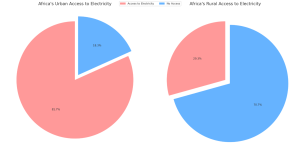The transformative threshold of Africa. Getting Africa on-line is not all about pulling together the disparate elements, but that this approach can be truly inspirational for the innovative technologies which shun conventional ‘hard-wired’ powers and embrace sustainable energy delivery. Despite all that, flickering of the previous shadows in some dimmed-down villages is the sign of change. Nevertheless, the narrative goes beyond the question of access and moves even further into green energy as light for illuminating our environment which is being over polluted at an unheard pace. This transformation encapsulates a dual ambition: clean and green lighting to homes, schools and factories, big and small, in this continent’s crowded cities and small villages under clear day and night skies. During the course of our discourse on details and stories surrounding Africa’s energy map, we will analyze more than just statistical aspects of electric power availability between towns and villages and the recent movement towards renewables – from darkness to sustainable light, which portrays an illuminating future.
We can also check the disparity between urban and rural areas in Africa.

Our initiative seeks to illuminate the African continent by expanding access to electricity, with the firm commitment to SDG 13.2—integrating climate change measures into national policies, strategies, and planning. We aim to electrify the future of Africa through the adoption of renewable energy solutions, ensuring that every watt powering development is also protecting our planet. By fostering the use of clean, renewable energy sources, we are not only turning on the lights but also paving the way for a sustainable and resilient energy ecosystem across African communities.
Increasing electric power consumption (kWh per capita) in Africa does not inherently lead to a rise in CO2 emissions (metric tons per capita) when we strategically incorporate renewable energy sources. By integrating solar, wind, hydro, and geothermal power into the energy mix, Africa can satisfy its growing energy needs while mitigating carbon footprint. This sustainable approach aligns with the global ambition to combat climate change, embodying the spirit of SDG 13.2. It demonstrates that economic growth and environmental stewardship can coexist, powering development that honors our collective commitment to a greener future.
We can see from this graph that in the European Union, increasing electric power consumption per capita did not lead to an increase in CO2 emissions per capita. This is due to the fact that they have increased their reliance on renewables, shown in the following graph.
In conclusion, the imperative for Africa is not just to electrify but to do so sustainably. Green energy solutions offer a pathway to empower the continent with the electricity it needs, without compromising the health of our planet. The adoption of renewable energy technologies in Africa represents a convergence of developmental aspirations with ecological responsibility. By harnessing the abundant renewable resources available, from solar to wind to hydro, Africa can leapfrog traditional, carbon-intensive energy models, setting a global example of sustainable growth. This approach not only addresses immediate energy needs but also aligns with long-term climate goals, fulfilling our collective responsibility to future generations.

0 Comments